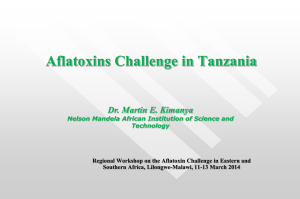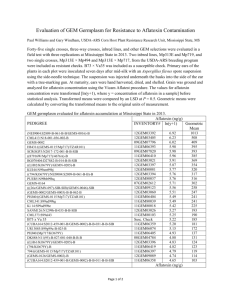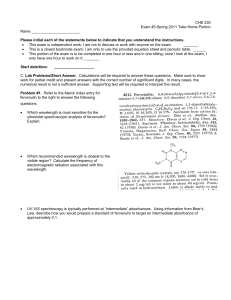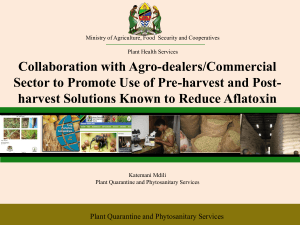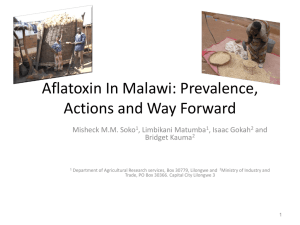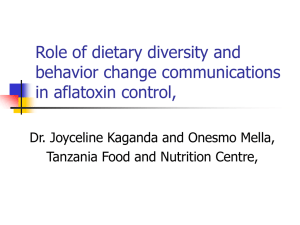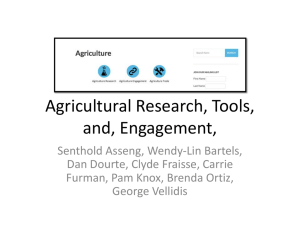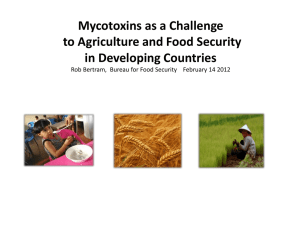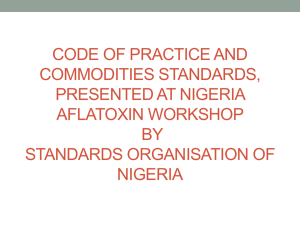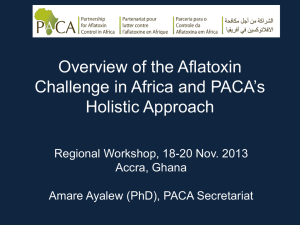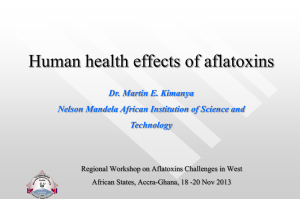Should Mycotoxins be mainstreamed in the Scaling
advertisement
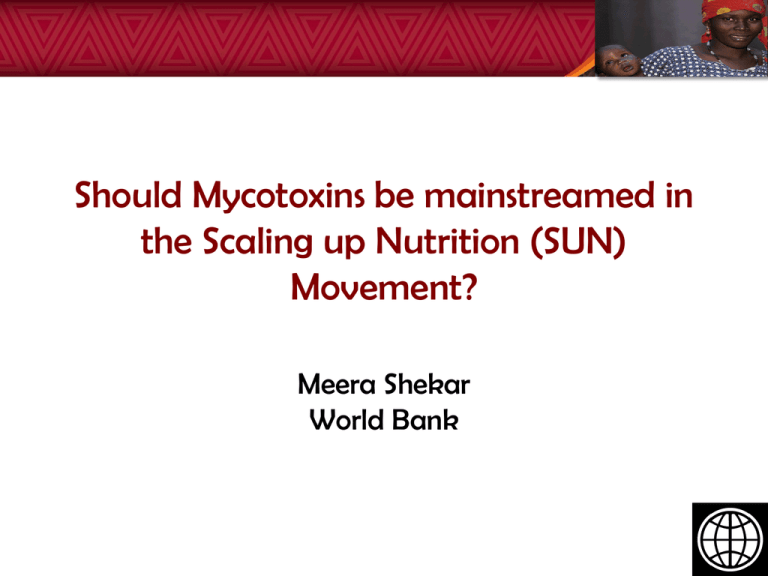
Should Mycotoxins be mainstreamed in the Scaling up Nutrition (SUN) Movement? Meera Shekar World Bank EXPOSURE TO AFLATOXINS • Maize and groundnuts are the major sources of aflatoxin exposure in humans. • Production of aflatoxin by fungi present in these crops can increase due to climatic factors such as drought stress, rainfall and insect damage. • Post-harvest conditions related to inappropriate food storage, transportation, and processing of crops can increase aflatoxin production. AFLATOXINS AND ADVERSE HEALTH OUTCOMES • Aflatoxins recognized as carcinogens by the International Agency for Research on Cancer in 1976 • Acute exposure can result in aflatoxicosis, which manifests as severe, acute hepatotoxicity with a case fatality rate of ~25% In 2004 and 2005 consecutive outbreaks of acute aflatoxicosis caused in Kenya caused more than 150 deaths • Chronic aflatoxin exposure, often in association with hepatitis B, can result in hepatocellular carcinoma Hepatocellular carcinoma is the sixth most prevalent cancer worldwide Burden of hepatocellular carcinoma attributable to aflatoxins is unknown • Chronic aflatoxin exposure may also lead to impaired immunity Strosnider et al. Workgroup Report: Public Health Strategies for Reducing Aflatoxin Exposure in Developing Countries. Environmental Health Perspectives. 2006;114(2):1898-1903. HUMAN EXPOSURE TO AFLATOXINS IN SUB-SAHARAN AFRICA • Studies in Ghana and Nigeria1, Kenya2, Sierra Leone3 and the Gambia4 have found detectable levels of aflatoxin in cord blood samples. • Several studies1,2,3,5,6,8 in sub-Saharan Africa have also detected aflatoxin in breast milk samples, which indicates that children may be exposed via breastfeeding. • Exposure to aflatoxins in early childhood typically increases when complementary foods are introduced, especially in regions where maize and groundnuts are dietary staples9. • Studies in the Gambia10, Guinea11, Benin and Togo12, 13, and Senegal4 found detectable levels of aflatoxin in the urine or serum of 85-100% of children sampled. • Many studies have detected aflatoxins in human body fluids more often in the wet season than the dry season. 1. Lamplugh et al. BMJ (Clin Res Ed), 1988; 2. Maxwell et al. Toxin Rev, 1989; 3. Jonsyn et al. Ann Trop Paediatr, 1995; 4. Wild et al. Lancet, 1991; 5. Coulter et al. Ann Trop Paediatr, 1984; 6. Jonsyn et al. Mycopathologia, 1995; 7. Wild et al. Int J Cancer, 1987; 8. Tchana et al. Int J Environ Res Public Health, 2010; 9. Khlangwiset et al. Crit Rev Toxicol, 2011; 10. Truner et al. Trop Med Int Health, 2000; 11. Polychronaki et al. Food Cehm Toxicol, 2008; 12. Gong et al. Int J Epi, 2003; 13. Gong et al. Environ Health Perspect, 2004. AFLATOXINS AND CHILD GROWTH Majority studies conducted in animals: • 29 of 30 studies reviewed showed an association between aflatoxin exposure and food intake an/or weight gain1 • 5 of 5 studies reviewed showed an association between aflatoxin exposure in utero and growth in early life1 A small number of observational studies involving humans have been conducted in sub-Saharan Africa: • Study of 125 infants in rural Kenya: mean birth weight of infants whose mothers had detectable aflatoxin in their blood was 255 g lower than that of infants whose mothers did not have aflatoxin2 • Cross-sectional study of 480 children in Togo and Benin found a dose-response relationship between aflatoxin levels in the blood and WAZ (p=0.005) and HAZ (p=0.001)3 • Study of 472 Gambian children 6-9 years of age did NOT find an association between aflatoxin levels and HAZ or WAZ4. However, a later study in the Gambia found an association between exposure to aflatoxin in utero and weight (p=0.012) and length gains (p=0.044) in the first year of life5. • Significant association between aflatoxin exposure and wasting (p=0.002) in Kenyan children 3-36 months of age. No association with stunting or underweight6. • Longitudinal study of 200 children 16-37 months of age showed strong negative correlation between blood aflatoxin levels and child growth (stunting) 1. Khlangwiset et al. Critical Reviews in Toxicology. 2011;41(9):740-755. 2. De Vries et al. Acta Paeditar Scand, 1989; 3. Gong et al. BMJ, 2002; 4. Turner et al. Environ Health Perspect, 2003; 5. Turner et al. Int J Epidemiol, 2007; 6. Okoth and Ohingo; Afr J Health Sci, 2004. INTERPRETATION OF THE EVIDENCE • Strong evidence showing exposure to aflatoxins is common among children in several sub-Saharan African countries where maize & groundnuts are dietary staples and included in complementary foods for infants. • This exposure is likely contributing to reduced immunity and morbidities (aflatoxicosis, hepatic carcinomas, etc) • Some evidence that post-weaning exposure to Aflatoxins impairs child growth • However, precise effects and pathways of aflatoxin exposure on child growth still unclear: • Most studies have been conducted in animals; • All human studies have been observational with relatively small sample sizes, and have produced mixed results. • These studies illustrate correlations between aflatoxin exposure and reduced growth, but do not prove causation (albeit RCTs not advisable/ethical) or pathways for impact • Aflatoxins may be one of many factors contributing to child stunting in sub-Saharan Africa, but more research is needed to establish causation and the precise burden. The “Window of Opportunity” for Improving Nutrition is very small… …pre-pregnancy until 18-24 months of age (1000 days) 0.50 Weight for age Z-score (NCHS) 0.25 0.00 -0.25 Latin America and Caribbean Africa Asia -0.50 Actions after age two Too late Too expensive Too little -0.75 -1.00 -1.25 -1.50 -1.75 -2.00 0 3 6 9 12 15 18 21 24 27 30 33 36 39 42 45 48 51 54 57 60 Age (m onths) Malnutrition usually happens from pre-pregnancy until 18-24 months of age (1000 days) and these losses in human capital are not recovered Repositioning Nutrition, 2006 Africa: the lagging region in the global fight against malnutrition Rate of under-five stunting A large number of the world’s malnourished children are in Africa (60 million stunted; + 30 million underweight; many more micronutrient deficient) & highest proportion of DALYs lost due to food-borne diseases. The Scaling Up Nutrition (SUN) Global Movement ONE unified and powerful call to action ...Building a Global Nutrition Movement Cornell University, USA Cornell University Division of Nutritional Sciences National Nutrition Institute, MOH Egypt THE WORLD BANK Public-Private Partnerships The International Life Science Institute Focal Point in China The multi-sectoral approach to improve nutrition Interventions under the SUN “Nutrition specific” interventions • Primarily through the health sector (Breast-feeding promotion, “Nutritionsensitive” interventions through • Agriculture….. • Social protection • Education • Water & Sanitation complementary feeding, Vitamin and mineral supplements, deworming, etc…) FROM A POLICY PERSPECTIVE • African children have high Aflatoxin exposure during the early years when child growth and human capital development is critical. • Though the mechanisms are not clear, the compromised immunity, and aflatoxinrelated morbidities are likely to impact on child growth and so should be considered among the potential “nutrition-sensitive interventions” under the SUN in high aflatoxin burden countries • Regardless of its direct impact on stunting, aflatoxin should not remain unregulated in Africa: • As of 2003, aflatoxin regulations existed for only five countries, including Kenya and South Africa • Focus should be on strategies that control aflatoxin-related risks in the field, post-harvest conditions, and the diet. • Public and governmental regulations needed to provide incentives to adopt interventions. For more information: Worldbank.org/nutrition Scalingupnutrition.org http://siteresources.worldbank.org/NUTRITION/Reso urces/281846-1131636806329/NutritionStrategy.pdf http://web.worldbank.org/WBSITE/EXTERNAL/TOPICS/EXTHEALTHN UTRITIONANDPOPULATION/EXTNUTRITION/0,,contentMDK:2255578 6~menuPK:282580~pagePK:64020865~piPK:149114~theSitePK:2825 75,00.html http://web.worldbank.org/WBSITE/EXTERNAL/COUNTRIES/LACEXT/EXTLACREGTOPHEANUTP OP/EXTLACREGTOPNUT/0,,contentMDK:21590613~pagePK:34004173~piPK:34003707~theSit ePK:4160378,00.html
